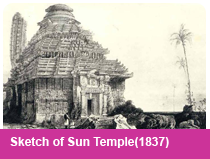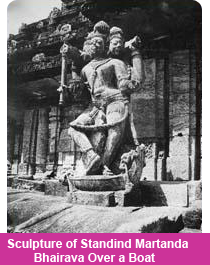- KONARK
- Monument
- Glorious Past
- Description
- Preserving Heritage
- Museum
- Sculpturs Gallery
- Fairs & Festivals
- Culture & Heritage
- Temples & Monuments
- Nature & Adventure
- Activities of Museum
- Old Galleries & Pedestals
- Improvement of Pedestals & Galleries
- Download Brochure
- About KONARK Museum
- Image Gallery
- Feedback
- Location Map
Glorious Past
The temple represents the highest water mark of the north Indian style of Kalinga architecture with its beginning in the seventh century temple at Bhubaneswar.
It is greatest of Odisha’s monuments also one of the glorious achievements of the mankind as a whole. Exquisitely carved, this is piece of architectural grandeur par excellence and living testimony of the artistic sensibility of a race that once knew how to live, love, worship, create and recreate.
Apart from laterite for the foundation for the core areas, they have chiseled out of the chlorite and khondalite everything from peace and agriculture to war and struggle from men, women and children to an endless variety of animals including the African animal giraffe and from the sensuous to righteousness.
Built in the 13th century by Narasimhadeva-I of the Ganga dynasty, it was conceived as a gigantic solar chariot with twelve pairs of ornamental wheels drawn by seven spirited horses. .
MARVEL OF ODISHAN ART
The temple consisted of a sanctum with a lofty sikhara (now lost), a jagamohana or an audience hall and a detached natamandira or dancing hall all in the same axis, besides other subsidiary shrines. The subsidiary shrines display superb images of morning, mid day and setting sun god in the three side projections. The main temple and jagamohana are in the same platform.
The European mariners called the temple ‘Black Pagoda’ which was helping them during their sea voyage. It was indicating their direction. The temple was too lofty; it was visible from miles together. Now the temple is in ruins but the jagamohana is quite intact. Though it is in ruin even then it testifies its former grandeur unrivalled by any temple in the world. Grand in its conception, great in its beauty, and high in its stature it stands today a most notable marvel of Odishan art.




 Archeological Museum Konark
Archeological Museum Konark Archeological Museum Konark
Archeological Museum Konark Archeological Museum Konark
Archeological Museum Konark Archeological Museum Konark
Archeological Museum Konark Archeological Museum Konark
Archeological Museum Konark Archeological Museum Konark
Archeological Museum Konark Archeological Museum Konark
Archeological Museum Konark Archeological Museum Konark
Archeological Museum Konark Archeological Museum Konark
Archeological Museum Konark Archeological Museum Konark
Archeological Museum Konark Archeological Museum Konark
Archeological Museum Konark Archeological Museum Konark
Archeological Museum Konark Archeological Museum Konark
Archeological Museum Konark Archeological Museum Konark
Archeological Museum Konark Archeological Museum Konark
Archeological Museum Konark Archeological Museum Konark
Archeological Museum Konark Archeological Museum Konark
Archeological Museum Konark Archeological Museum Konark
Archeological Museum Konark Archeological Museum Konark
Archeological Museum Konark Archeological Museum Konark
Archeological Museum Konark Archeological Museum Konark
Archeological Museum Konark Archeological Museum Konark
Archeological Museum Konark Archeological Museum Konark
Archeological Museum Konark

